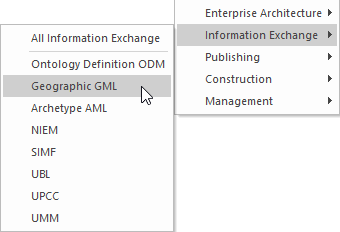| Prev | Next |
Modeling with GML
You can create GML models using the powerful diagramming and modeling facilities in Enterprise Architect. FIrst you need to select the GML or Information Exchange Perspective. Perspectives are a powerful focusing tool facility that ensure you remain focused and can concentrate on GML modeling.

Perspective menu - GML perspective selection
This activates the MDG Technology for GML which contains the UML Profile for GML allowing you to create models with elements and connectors that describe your organization or community domains.
Access
|
Ribbon |
Specialize > Technologies > GML |
|
Context Menu |
Right-click on Package | Specialize | GML |
Features
Feature |
Detail |
See also |
|---|---|---|
|
Profile Support |
You can develop GML constructs quickly and simply, through use of the built-in MDG Technology for GML facilities provided in the form of:
|
Add New Diagrams Diagram Toolbox Toolbox Shortcut Menu The Quick Linker |
|
GML Toolbox Page |
The GML Toolbox pages contain elements and connectors to model geographical features effectively. |
GML Toolbox Pages |
|
UML Classes from ISO |
(Optional) You can download the UML Classes implemented in ISO/TC 211 as an XMI file, then import the XMI file into Enterprise Architect as a Package containing diagrams and standard UML Classes, which you can reuse in your model.
|
Import from XML |
|
GML Application Schema Generation |
Any model you create using the built-in MDG Technology for GML can be exported as a GML Application Schema. Using the configurable file GMLStereotypes.xml in the 'Sparx Systems > EA > Config > GML' folder, you can specify aliases for the standard GML stereotypes. The GML Application Schema Generator will also consider these aliases during Schema generation. |
Generate GML Application Schema |
Notes
- The MDG Technology for GML is available in the Professional, Corporate, Unified and Ultimate Editions of Enterprise Architect